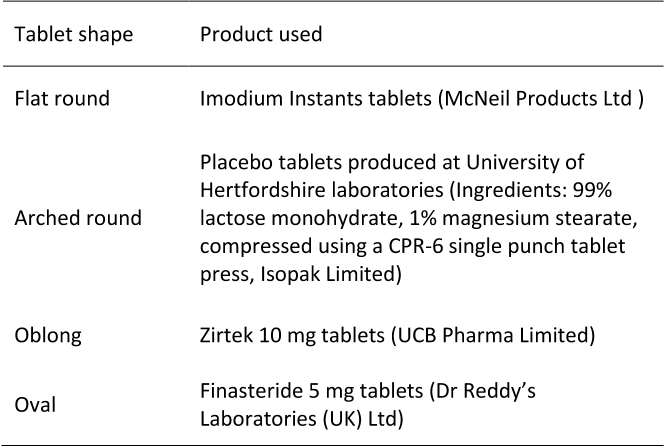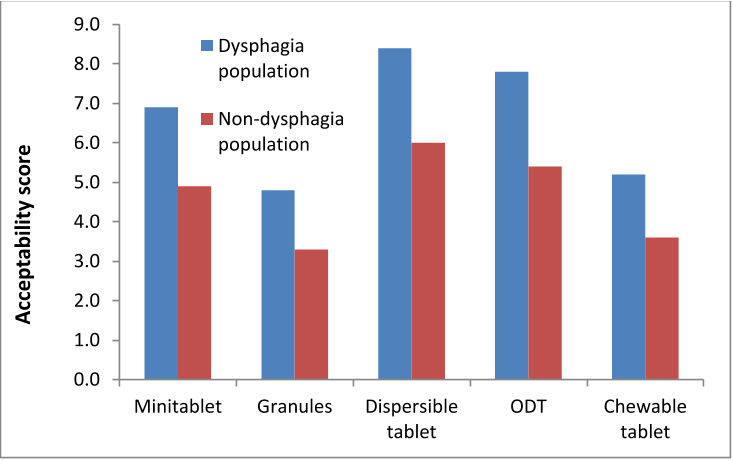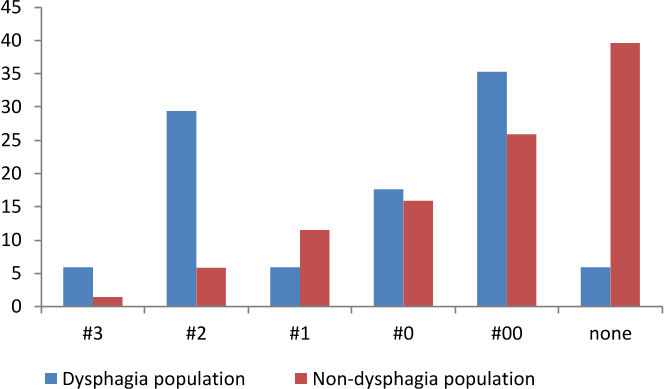Acceptability of oral solid medicines in older adults with and without dysphagia: A nested pilot validation questionnaire based observational study
TL;DR: Assessment of acceptability of oral solid medicines in older ambulatory patients with and without dysphagia found that higher acceptability scores were seen in the dysphagic population than in the non-dysphagic population for all of the dosage forms that were easier to swallow than tablets and capsules.
About: This article is published in International Journal of Pharmaceutics.The article was published on 2016-10-30 and is currently open access. It has received 71 citations till now. The article focuses on the topics: Dysphagia & Population.
Summary (2 min read)
Jump to: [1. Introduction] – [2.2 Administration of the Sydney Swallow Questionnaire (SSQ)] – [2.3 Pilot of the Medicines Acceptability Questionnaire (MAQ)] – [2.4 Data analysis] – [3.1 Validation of the Medicines Acceptability Questionnaire (MAQ)] – [3.4 Acceptability of alternative solid oral dosage forms] – [4. Discussion] and [5. Conclusions]
1. Introduction
- Previous knowledge on these effects has been demonstrated in healthy young subjects; however, this remains unclear in older people especially those with existing swallowing difficulties.
- The type of formulation might be another factor affecting the ability and willingness of older patients to take their medicines.
- A number of solid oral dosage forms that are "easier to swallow" than tablets and capsules have been made available in recent years including orally disintegrating tablets (ODTs), dispersible tablets, mini-tablets and multi-particulates .
- For older patients who cannot swallow tablets, the availability of these formulations could be beneficial.
2.2 Administration of the Sydney Swallow Questionnaire (SSQ)
- The SSQ is a validated questinnarie and composed of 17 questions assessing oral and pharyngeal swallowing function with responses entered onto a 101 mm visual analog scale except for question 12 (R. C. Dwivedi et al., 2010; K. L. Wallace et al., 2000) .
- The SSQ was administered to the participants during an interview which took place in the private consultation room in the pharmacy.
- The participant placed a mark on the horizontal line of the visual analog scale.
- The first millimeter of the line was disregarded and a score of 0-100 was calculated by measuring the distance from the center of the mark to the first millimeter of the line for each question.
- The maximum possible total score for the SSQ was 1700, with higher score indicating greater severity of swallowing dysfunction.
2.3 Pilot of the Medicines Acceptability Questionnaire (MAQ)
- The content/face validity of the MAQ was assessed by two experts in the field acting as respondents.
- Cronbach's alpha test was conducted to evaluate the level of reliability and internal consistency using the Statistical Package of the Social Sciences (SPSS) version 22.0 (IBM Corp., Armonk, NY, USA).
- Cronbach's alpha scores of 0.7 or above were deemed as acceptable according to Nunnally and Bernstein (J. Nunnally and L. Bernstein, 1994) .
- The MAQ was administered to the participants during the interview together with the SSQ.
- The interviews were conducted by two of the authors (AG and JB).
2.4 Data analysis
- Data analysis was performed using the Statistical Package of the Social Sciences (SPSS) version 22.0 (IBM Corp., Armonk, NY, USA).
- The results are reported as mean ± standard deviation (SD).
- Spearman's nonparametric correlation was used to identify the presence of significant correlations between total SSQ score and age of participants or number of solid oral medicines taken daily.
- The Mann-Whitney U test was conducted to assess links between gender of participants and total SSQ score, and comparing the means of participants' selfperceived health status between the dysphagia and non-dysphagia group.
- Chi-Square test was conducted to evaluate the relationship between dysphagic status of the participant and difficulty in swallowing tablets and capsules.
3.1 Validation of the Medicines Acceptability Questionnaire (MAQ)
- 3 Ability to swallow tablets and capsules in patients with and without dysphagia by the MAQ A total of 12 (7.8%) participants experienced ongoing difficulties in swallowing tablets and capsules according to the results from the MAQ.
- Figure 1 shows percentage of participants who has chosen the size and shape of tablets that were perceived as starting to cause difficulty in swallowing.
- The majority of participants with dysphagia found that tablets of sizes 11 mm and 13 mm might started to cause difficulties in swallowing; the percentages of participants selecting 11 mm or 13 mm were 52.9%, 52.9%, 58.8% and 64.7% for flat round, arched round, oblong and oval tablets respectively.
- Similar results were observed regarding difficulties in swallowing capsules of different sizes in participants with and without dysphagia .
- In participants with dysphagia, over a third (35%) selected size #00 as that which started to cause problems in swallowing; however, around 30% of these participants also considered size #2 to be difficult to swallow.
3.4 Acceptability of alternative solid oral dosage forms
- A low proportion of participants had had experience of using the alternative solid oral dosage forms, except for dispersible/effervescent tablets which were referenced mainly to soluble paracetamol and dispersible aspirin tablets as examples (Table 3 ).
- The acceptability scores of different oral solid dosage forms are shown in Figure 3 .
- Participants described the good/bad points they considered for each formulation as listed in Table 4 .
4. Discussion
- A range of medicine formulations have been made available for patients who find it difficult to swallow tablets and capsules.
- The acceptability of these formulations in targeted patient groups is often unclear.
- Studies have reported that increasing age is associated with increased severity and prevalence of dysphagia in elderly populations (G. Holland et al., 2011; K. Kawashima et al., 2004) .
- Szcaesniak et al. studied SSQ score in a non-dysphagic population and found that there was no significant correlation between age and SSQ score (M. M. Szczesniak et al., 2014) .
5. Conclusions
- A significant proportion of older patients attending community pharmacies have symptoms compatible with dysphagia.
- These patients are more likely to have difficulties in swallowing tablets and capsules compared to those with no dysphagia.
- Healthcare professionals should identify patients with high risk of having problems swallowing their medicines and assist in selecting most appropriate medicine dosage forms.
- The development and availability of alternative oral formulations other than conventional tablets and capsules will likely to assist in medication administration and management in patient with dysphagia and might lead to better adherence.
Did you find this useful? Give us your feedback
Figures (7)

Table 1. Products used to represent 9 mm tablets in different shapes 
Table 2. Products used to represent various oral formulations 
Fig 3. Acceptability scores of different oral solid dosage forms (ODT: orally disintegrating tablet). 
Table 4. Participants’ impression on the flexible solid oral dosage forms. 2 
Figure 1. Percentage of participants selecting the tablet size and shape that started to cause difficulty in swallowing. 
Fig 2. Percentage of participants selecting the capsule size that might start to cause difficulty in swallowing 
Table 3. Number of participants who had previously used the flexible solid oral formulations.
Citations
More filters
TL;DR: An overview of the advantages and limitations of 3D printing for drug delivery and testing, as compared to traditional manufacturing techniques is provided.
167 citations
Cites background from "Acceptability of oral solid medicin..."
...Ease of swallowing Beyond the technical aspect of pharmaceutics, in terms of user experience, current oral solid dosage forms can also be difficult to swallow, especially for special populations including the geriatrics [65] and paediatrics [66]....
[...]
TL;DR: This study is the first to guide the pharmaceutical industry towards developing patient-centric medicine in different geometries via 3DP, with the highest acceptability scores for torus printlets indicating that FDM 3DP is a promising fabrication technology towards increasing patient acceptability of solid oral medicines.
160 citations
Cites background from "Acceptability of oral solid medicin..."
...In relation to orally administered dosage forms, the effect of palatability and size of the drug product on patient acceptability have been studied in recent years (Liu et al., 2016; Mittal, 2017)....
[...]
TL;DR: This review provides a comprehensive and up-to-date analysis of oral dosage forms considering key aspects of formulation design including dosage considerations, ease of use, tolerability and safety, manufacturing complexity, stability, supply and cost.
68 citations
TL;DR: Packaging, orodispersible formulations, fixed dose combinations products, multiparticulate formulations, topical formulations and 3D printing are of particular relevance in a PCDPD process and will be addressed in this review.
Abstract: Medication adherence is a growing concern for public health and poor adherence to therapy has been associated with poor health outcomes and higher costs for patients. Interventions for improving adherence need to consider the characteristics of the individual therapeutic regimens according to the needs of the patients. In particular, geriatric and paediatric populations as well as dermatological patients have special needs/preferences that should be considered when designing drug products. Patient Centric Drug Product Pharmaceutical Design (PCDPD) offers the opportunity to meet the needs and preferences of patients. Packaging, orodispersible formulations, fixed dose combinations products, multiparticulate formulations, topical formulations and 3D printing are of particular relevance in a PCDPD process. These will be addressed in this review as well as their impact on medication adherence.
51 citations
Cites background from "Acceptability of oral solid medicin..."
...Indeed, the patient’s adherence is generally improved with respect to conventional solid dosage forms [92,98]....
[...]
TL;DR: This review condense the findings, summarize the improvements that are needed for the use of 3D printing in medicine, as well as plausible methods for creating medicines and medical devices in the future.
47 citations
References
More filters
TL;DR: The chewing ability of 260 long-term hospitalized elderly patients in Laakso hospital, Helsinki, Finland, was investigated and it was found that excellent or moderate ability to chew was related to a subject's lesser degree of dependence and higher Eichner Score.
Abstract: We investigated the chewing ability of 260 (25 percent men) long-term hospitalized elderly patients 60 years of age and older in Laakso hospital, Helsinki, Finland, in relation to their mastication capacity, sore mouth and degree of dependence. The subjects' (mean age 83.3 years, SD = 8.1 years) mastication capacity was determined by a specialist dentist by means of:
(a) number of functioning teeth and dentures; (b) modified Eichner Index; and (c) the Eichner Score, based on the index. Based on the information given by the nursing staff, an indicator of chewing ability was created. The chewing ability was poor for 55 percent, limited for 17 percent, moderate for 14 percent and excellent for 14 percent. Excellent or moderate ability to chew was related to a subject's lesser degree of dependence (OR = 1.5; p = 0.02) and higher Eichner Score COR = 1.3; p = 0.000). More attention should be focused on mastication capacity of the hospitalized elderly.
9 citations
TL;DR: In this study conducted in Lithuania with depressed patients, a significant improvement was shown in all efficacy measures and mirtazapine orally disintegrating tablet was a well-tolerated and preferable formulation for the treatment of depressed patients.
Abstract: Mirtazapine is an established antidepressant with well-documented efficacy demonstrated in controlled clinical trials. However, the gap between the results obtained in controlled clinical trials and everyday clinical practice exists. Therefore, the importance of naturalistic studies in psychiatry is becoming recognized. The aim of present naturalistic study was to acquire data on efficacy, safety, and preference of mirtazapine orally disintegrating tablets during a 17-week treatment of depression. This prospective, open-label, multicenter study in patients with mild to severe depression was conducted at 47 mental health centers of Lithuania by 78 psychiatrists. Patients were initially given 15 mg or 30 mg of mirtazapine orally disintegrating tablets; the maximum allowed dose was 45 mg per day. The primary efficacy measure was the total score on the Hamilton Depression Rating Scale-17 (HAMD-17), the Clinical Global Impression-Severity (CGI-S), and Clinical Global Impression-Improvement (CGI-I) scales. Tolerability was primarily measured by assessing the incidence of treatment-emergent adverse events. Patients were evaluated at baseline, at weeks 1, 5, 9, 13, and 17. A total of 779 patients (595 women [76.4%] with a mean [SD] age of 50.2 [13.65] and 184 men [23.6%] with a mean [SD] age of 52.4 [14.6] years) were enrolled into the study; 687 (88.2%) patients completed the study. The mean (SD) daily dose of mirtazapine orally disintegrating tablets was 29.0 (3.8) mg. The mean total (SD) HAMD-17 score improved significantly from 25.7 (4.6) to 7.3 (4.3) (P<0.005). At each visit, the mean HAMD-17 score was significantly lower than that at the preceding visit. At week 17, remission (HAMD-17 score < or =7) was observed in 436 (56%) patients. The mean (SD) CGI-S score improved significantly from 4.9 (1.0) at baseline to 1.5 (0.6) at endpoint (P<0.001). According to the CGI-I assessments, 621 patients (89.4%) improved and improved very much. The vast majority of patients (80%) preferred the new formulation of mirtazapine – mirtazapine orally disintegrating tablet. Treatment-emergent adverse events occurred in 106 patients (13.6%). The most frequent adverse events were weight gain, sedation, dizziness, and dry mouth. In this study conducted in Lithuania with depressed patients, a significant improvement was shown in all efficacy measures. In addition, mirtazapine orally disintegrating tablet was a well-tolerated and preferable formulation for the treatment of depressed patients.
9 citations
Journal Article•
TL;DR: The processes through which drugs are handled by the body are briefly described and common problems associated with medication and the elderly are discussed.
Abstract: This article is the first of two looking at medication-related problems in the elderly The processes through which drugs are handled by the body are briefly described and common problems associated with medication and the elderly are discussed A case study is presented to illustrate some of these issues The second article on this subject will appear in next week's Nursing Times
5 citations